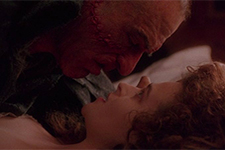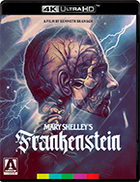Mary Shelley's Frankenstein (4K UHD)
|  Flamboyant, melodramatic, full of sound and fury and fire and lightning and blood and amniotic fluid, Kenneth Branagh’s film of Mary Shelley’s Frankenstein is a feverishly ambitious work that was disowned by both its producer (Francis Ford Coppola) and one of its screenwriters (Frank Darabont), tepidly received by critics, and largely ignored by audiences. It is a shame, really, especially since it followed Coppola’s critically and commercially successful Bram Stoker’s Dracula (1992) and was clearly meant to establish a new, modern series of cinematic adaptations of the Gothic classics that helped create the horror genre in the late 1800s (unfortunately, there would be no Robert Louis Stevenson’s Dr. Jekyll and Mr. Hyde or Dr. John Polidori’s The Vampyre). Critics at the time hammered Branagh for being overwrought and pretentious as both director and actor, but looking at the film now, his over-the-top approach feels right for the material, injecting it with new life while simultaneously staying largely faithful to the original novel, which had already spawned hundreds of stage, film, and television adaptations. Branagh, already a veteran of the British stage in his mid-20s, burst onto the cinematic scene as a young director-actor hyphenate in 1989 with his gloriously muddy and bloody adaptation of William Shakespeare’s Henry V, which he quickly followed with the outlandish and theatrical reincarnation murder-mystery Dead Again (1991), the reunion comedy Peter’s Friends (1992), and an adaption of Shakespeare’s romantic comedy Much Ado About Nothing (1993). Given his previous works, it is perplexing that critics were somehow surprised and put off by the theatricality of Mary Shelley’s Frankenstein, as if any of Branagh’s previous works suggested that he would somehow reign it all in when handed an adaptation of one of the great Gothic novels. Written by Steph Lady and Frank Darabont (the same year he wrote and directed The Shawshank Redemption), this version of Frankenstein sticks much closer to Shelley’s 1818 novel than most previous adaptions, especially in its maintenance of the frame story involving a driven Arctic explorer named Walton (Aidan Quinn), whose ship has become trapped in the ice while trying to reach the North Pole. He meets an exhausted and near-death Victor Frankenstein (Branagh), who has been pursuing the Creature (Robert De Niro) he created and rejected. Frankenstein recognizes the folly of his unnatural endeavor, and he sees in Walton a similarly driven man of science who is destined for disaster, which is why he relates his story to him. Thus, we meet Victor as a child, growing up the son of a wealthy doctor (Ian Holm) in Geneva in the late 1700s (unlike so many adaptations, this one keeps the late 18th-century time frame of the novel, rather than moving it up to the period of its publication). Victor’s subsequent life is shaped enormously by two women: his mother (Cherie Lunghi), who dies in childbirth, and Elizabeth (Helena Bonham Carter), an adopted sister with whom he later falls in love. Distraught by his mother’s death and determined to save others from similar anguish, Victor studies medicine at the University of Ingolstadt, where he comes into constant conflict with his professors, who have no time for his interest in outside-the-box practices geared toward reanimating the dead. He strikes up a friendship with a fellow medical student, Henry (Tom Hulce), and eventually finds a like mind in Professor Waldman (John Cleese), who is also interested in reanimation and has conducted experiments toward that end. Obsessed with his work, Victor eventually succeeds in bringing back to life a stitched-together corpse, the majority of which belonged to a common thief who stabbed Waldman to resist getting a cholera vaccine (the incorporation of a cholera epidemic gives the film an additional sense of historical horror, and it makes for a particularly intriguing watch in the age of COVID). Because Shelley completely avoided describing how Frankenstein created his Creature, every movie and stage adaptation has been at liberty to imagine it anew, and Branagh infuses his creation sequence with a passion and urgency that is almost breathtaking. Sweeping through his enormous attic laboratory in a long red robe while the musical score by Patrick Doyle (a regular collaborator of Branagh’s since Henry V) pounds on the soundtrack, Frankenstein goes through the final steps of the creation process with a feverish intensity that suggests a man working outside of logic and reason, driven by a compulsion he has long since given up on trying to understand; it truly embodies Shelley’s first-person description of Frankenstein’s creative mania: “No one can conceive the variety of feelings which bore me onwards, like a hurricane, in the first enthusiasm of success.” But, conceive Branagh does, making great use of the elaborate production design by Tim Harvey (a veteran of British television and regular Branagh collaborator), which is both sumptuous and weirdly grounded in the science of the era, with Frankenstein using electric eels to produce energy and bringing his creation to life in a giant, sealed vat (reminiscent of the enclosure depicted in the silent 1910 version produced by the Thomas Edison Co.) that is filled with amniotic fluid, which we earlier saw Frankenstein procuring from midwives. The sequence is, at its heart, fundamentally cinematic and enthralling, making it the best thing in the film. The energy that animates the creation sequence is sometimes misspent in other parts of the film, which we see most clearly in the tendency of cinematographer Roger Pratt (who shot most of Terry Gilliam’s films, including Brazil and 12 Monkeys) to swirl the camera vertiginously (and sometimes pointlessly) around characters as they talk. However, as bombastic as the film can be, Branagh is attuned to the importance of the underlying emotions that drive both Frankenstein’s scientific impulses and his Creature’s response to being given unnatural life and then rejected by his creator. With his chiseled abs and shaggy rock-star locks, Branagh’s Frankenstein is more Byronic tragic artist than ego-maniac with a God complex, which makes him stand apart from so many previous cinematic interpretations of the character. De Niro’s Creature is suitably tragic, and the fact that he develops language and is allowed to express his torment in words makes him a unique screen version that maintains Shelley’s vision of an articulate monstrosity whose greatest misfortune is own self-awareness. The middle section of the film is given over to a lengthy subplot (taken directly from the novel) in which the Creature takes up secret residence in the barn of a poor farming family. Desperate for human connection, he helps them unseen, leading them to the belief that they are being aided by a forest spirit. The Creature is eventually invited into the home by the blind grandfather (Richard Briers), a moment of potential salvation that is wrecked by the arrival of the rest of the family, who are horrified by the Creature’s appearance and (understandably) mistake him for a threat. The subsequent shot in which the Creature sits alone in the snow at the base of a tree wailing abjectly is both emotionally devastating and central to the film’s vision—consistent with Shelley’s novel—of the Creature as a complex and tragic figure. De Niro’s performance is crucial here, as he balances the Creature’s thirst for vengeance against Frankenstein with his sad desire to be accepted by humanity. And that is what makes Mary Shelley’s Frankenstein work. When Shelly wrote the novel, she was fascinated and to an extent driven by new scientific realities, but she was primarily concerned with the human condition. Her novel—and Branagh’s film—does not so much frighten us as it does dig into the deep philosophical conundrum of what it means to be human. Frankenstein’s story still speaks to us because it is about basic human nature. Like so too many, Frankenstein’s Creature was born innocent, but through a series of events not of his choosing, he was turned into a hateful wretch who could think of nothing but inflicting evil on humankind and avenging himself on his creator. As the Creature puts it in Shelley’s novel, he “declared ever-lasting war against the species, and, more than all, against him who had formed me, and sent me forth to this insupportable misery.” That misery is central to Frankenstein, and it is the emotion that Branagh best captures in both the creator and the created and their intertwined fates.
Copyright © 2022 James Kendrick Thoughts? E-mail James Kendrick All images copyright © Arrow Video | |||||||||||||||||||||||||||||
Overall Rating: 

 (3)
(3)


